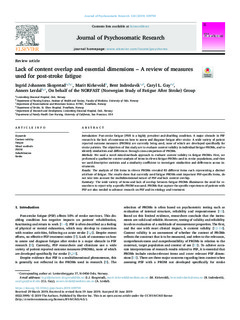| dc.contributor.author | Skogestad, Ingrid Johansen | |
| dc.contributor.author | Kirkevold, Marit | |
| dc.contributor.author | Indredavik, Bent | |
| dc.contributor.author | Gay, Caryl | |
| dc.contributor.author | Lerdal, Anners Vetle | |
| dc.date.accessioned | 2019-08-20T07:14:55Z | |
| dc.date.available | 2019-08-20T07:14:55Z | |
| dc.date.created | 2019-08-13T12:23:46Z | |
| dc.date.issued | 2019 | |
| dc.identifier.issn | 0022-3999 | |
| dc.identifier.uri | http://hdl.handle.net/11250/2609242 | |
| dc.description.abstract | Introduction
Post-stroke fatigue (PSF) is a highly prevalent and disabling condition. A major obstacle in PSF research is the lack of consensus on how to assess and diagnose fatigue after stroke. A wide variety of patient reported outcome measures (PROMs) are currently being used, none of which are developed specifically for stroke patients. The objectives of this study are to evaluate content validity in individual fatigue PROMs, and to identify similarities and differences through cross-comparison of PROMs.
Methods
We used a novel mixed-methods approach to evaluate content validity in fatigue PROMs. First, we performed a qualitative content analysis of items in eleven fatigue PROMs used in stroke populations, and then we used descriptive statistics and a similarity coefficient to investigate similarities and differences across instruments.
Results
The analysis of 156 items in eleven PROMs revealed 83 different items each representing a distinct attribute of fatigue. The results show that currently used fatigue PROMs omit important PSF-specific items, do not take into account the multidimensional nature of PSF and lack content overlap.
Summary
The wide variety of items and lack of overlap between fatigue PROMs illuminates the need for researchers to report why a specific PROM was used. PROMs that capture the specific experiences of patients with PSF are also needed to advance research on PSF and its etiology and treatment. | nb_NO |
| dc.language.iso | eng | nb_NO |
| dc.publisher | Elsevier | nb_NO |
| dc.rights | Attribution-NonCommercial-NoDerivatives 4.0 Internasjonal | * |
| dc.rights.uri | http://creativecommons.org/licenses/by-nc-nd/4.0/deed.no | * |
| dc.title | Lack of content overlap and essential dimensions – A review of measures used for post-stroke fatigue | nb_NO |
| dc.type | Journal article | nb_NO |
| dc.type | Peer reviewed | nb_NO |
| dc.description.version | publishedVersion | nb_NO |
| dc.source.volume | 124 | nb_NO |
| dc.source.journal | Journal of Psychosomatic Research | nb_NO |
| dc.identifier.doi | 10.1016/j.jpsychores.2019.109759 | |
| dc.identifier.cristin | 1715562 | |
| dc.description.localcode | © 2019 The Authors. Published by Elsevier Inc. This is an open access article under the CC BY-NC-ND license (http://creativecommons.org/licenses/BY-NC-ND/4.0/). | nb_NO |
| cristin.unitcode | 1920,15,0,0 | |
| cristin.unitcode | 194,65,30,0 | |
| cristin.unitname | Medisinsk klinikk | |
| cristin.unitname | Institutt for nevromedisin og bevegelsesvitenskap | |
| cristin.ispublished | true | |
| cristin.qualitycode | 1 | |

